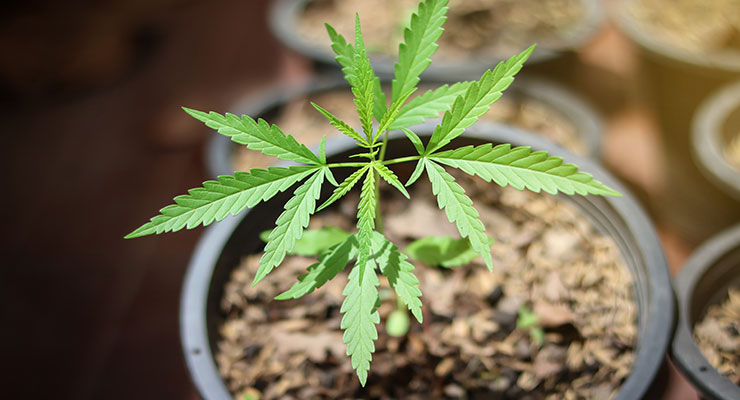Features
Beyond CBD: Cannabis Compounds Warrant Recognition and More Research
With growing consumer usage, scientists must continue exploring the many constituents of cannabis, their interactions, and potential health effects.

By: Sean Moloughney

Cannabis has been held back by prohibition for decades, hamstringing research efforts and limiting consumer access. However, with market momentum building, science has been breaking through barriers to better explore potential applications in food/beverages, dietary supplements, pharmaceuticals, and more.
As a 501(c)(3) non-profit, Realm of Caring (RoC) is committed to research into novel healthcare options to improve quality of life and has served tens of thousands of families and healthcare professionals since its inception in 2013. Through research and education, RoC is facilitating the mainstream acceptance of cannabinoid-based therapies and building an empowered community.
“In partnership with Johns Hopkins University School of Medicine, our Observational Research Registry (ORR) is the largest cannabinoid therapy research program in the U.S.,” said Matthew Lowe, PhD, director of research at RoC. “The registry is an Institutional Review Boards-approved, longitudinal survey study examining the health effects of medicinal cannabis use, and it’s open to anyone in the world with internet access.”
The cannabis plant contains more than 500 compounds, including about 125 phytocannabinoids that produce pharmacological effects through their interaction with cannabinoid receptors, Lowe explained. “Major cannabinoids that have been identified include delta-9-tetrahydrocannabinol (delta-9-THC; the main psychoactive constituent of cannabis), cannabidiol (CBD), tetrahydrocannabivarin (THCV), cannabinol (CBN), cannabigerol (CBG), and cannabichromene (CBC).”
In many ways, CBD has blazed a fresh path for more nuanced dialogue about cannabis and its components. “CBD serves as a great point of entry for someone navigating the world of cannabinoid therapy,” said Sasha Kalcheff-Korn, executive director of the RoC Foundation. “It’s a domino effect of sorts: a consumer realizes the potential of this one singular cannabinoid then begins educating themselves on the potential of the many other cannabinoids, terpenes, and flavonoids that have therapeutic properties of their own. Understanding the mechanisms of action of CBD through research is paving the way for opportunities with the additional compounds of the Cannabis sativa plant as well.”
Non-cannabinoid constituents of cannabis include terpenes, phenols, flavonoids, alkaloids, and more, Lowe noted. “Critically, evidence suggests non-cannabinoid compounds work synergistically with cannabinoids to produce distinct effects on the body. Research indicates terpenes (compounds that are responsible for the characteristic aroma of the plant) play a significant role in the effects produced by cannabis.”
For example, the terpene caryophyllene, commonly known as beta-caryophyllene (BCP) has shown therapeutic potential in neuropathic pain, renal protection, depression, and anxiety, according to Lowe. Other common terpenes include linalool, myrcene, humulene, beta-pinene, and limonene.
“The therapeutic benefits of cannabis are dependent on the interplay between various cannabis constituents,” Lowe said. “While researchers are still examining precisely how these constituents interact to produce distinct effects on the body, it has become increasingly apparent that both cannabinoids and non-cannabinoids have significant therapeutic potential.”
Meanwhile, the nutritional profile of hemp seeds and hemp hearts are impressive, containing protein, vitamins, essential amino acids, and omega-3, -6, and -9 fatty acids. “Whole hemp seeds contain a greater amount of fiber and minerals, which are found primarily in the hull,” Lowe noted. “One might say that hemp seeds have the ability to offer total nutrition for the body. They contain high levels of omega-3 and omega-6 fatty acids and are a great source of protein in that they provide all nine essential amino acids.”
Hemp seed also offers an assortment of minerals and vitamins such as magnesium, potassium, iron, zinc, vitamin B, and vitamin E. Of note, hemp seeds contain the omega-6 fatty gamma-linolenic acid, which is also found in breast milk. “This vast nutritional profile may benefit as a neuroprotectant, anti-inflammatory, and immune and heart health regulator,” Lowe said.
Historical and Modern Use
Evidence of cultivation and medical use of cannabis dates back to about 2900 B.C. in what is now modern China. “There’s a history of use in Eastern medicine as an analgesic, hypnotic, tranquilizer, antispasmodic, and anti-inflammatory agent,” Lowe said. “However, it wasn’t until the early 19th century that the medicinal use of cannabis was more fully explored in Western medicine.”
The modern era of scientific study of individual cannabinoids began in the 1940s, he explained. “In 1964, the chemical structure of delta-9-THC was identified by Yechiel Gaoni and Raphael Mechoulam, a discovery that significantly contributed to the proliferation of studies examining the active constituents of cannabis. By the 1980s, Allyn Howlett and colleagues provided definitive evidence for the existence of cannabinoid receptors, leading to the discovery of the endocannabinoid system (ECS). Since then, the exploration of cannabis derivatives as medication has rapidly advanced.”
While restrictive regulation made cannabis research difficult for many decades, “there are currently nearly 28,000 peer-reviewed articles on cannabis in the U.S. National Library of Medicine,” Lowe noted. “The therapeutic potential of cannabis is now well known, but its mechanisms of action on the human nervous system, treatment effectiveness, and safety are still being explored.”
The Path Ahead
Looking forward, with “rapidly increasing usage” among consumers, it’s critical to continue exploring the merits of medicinal cannabis, said Lowe. “At RoC, we hope and believe that the approach to cannabis research will focus on individualized medicine. Since 2016, the RoC has conducted ongoing observational research in collaboration with Johns Hopkins University School of Medicine to explore what consumers are using in real-world settings, and to examine consumers’ self-reported health outcomes.”
Still, regulatory uncertainty continues to affect market potential. “Regulation is necessary to protect consumers who deserve to know the product they are purchasing is safe,” said Kalcheff-Korn, “and regulations can ensure testing and other safety protocols are followed. Without regulation, there are safety concerns in the market and the consumer is left to do their own homework on companies versus trusting the quality of the products marketed to them.”
With proper regulation and high quality products, opportunities in food, supplements and pharmaceuticals abound. Hemp and cannabis “may have the ability to significantly benefit not only our health but also the environment with great agricultural potential and industrial significance. To limit the opportunities of these plants seems almost criminal,” she said.


